When it comes to alien visitors the Earth does seem to attract a lot of the “evil invader” types because for every E.T. The Extraterrestrial or Starman we get a half-dozen aliens who have "regarded this Earth with envious eyes and slowly and surely, they drew their plans against us" but in 1951 director Robert Wise helmed a science fiction classic that strode the line between the aspects of both invading and benevolent aliens.
Loosely based on the Harry Bates short story “Farewell to the Master” Robert Wise’s The Day the Earth Stood Still can be considered one of the earliest examples of a science fiction movie that worked as fun escapist entertainment while also being a message picture, a not too subtle one with the main protagonist bluntly stating “Knock off this nuclear bomb shit or you will be destroyed” and it’s through this societal lens that we get one of the best examples in the genre, one that would later be greatly explored by Gene Rodenberry on his television series Star Trek. For this science fiction tale, screenwriter Edmund H. North penned a very tight and simple script one that director Robert Wise then utilized with a documentary-style approach, so as to give the film a more believable quality to offset its more fantastic elements. The arrival of a flying saucer and its subsequent landing in Washington, D.C. is treated as “Breaking News” and the military's reaction to such an impromptu visit from outer space is only one of many of those believable aspects that Wise peppers throughout the film.
Note: Production designers Thomas Little and Claude Carpenter collaborated with the architect Frank Lloyd Wright for the amazing design of the spacecraft.
The basic plot of The Day the Earth Stood Still follows the events of a flying saucer landing on the grassy fields of a baseball complex to which out of the belly of the craft comes Klaatu (Michael Rennie), an alien visitor our world, but who is then almost immediately shot by a trigger-happy soldier. This action results in a more menacing figure emerging from the craft, Gort, a towering eight-foot-tall robot that unleashes a powerful beam that vaporizes rifles, tanks and artillery guns. Lucky for the military Klaatu calls off the robot before it can lay waste the entire army and allows himself to be taken to Walter Reed Hospital where he tries his best to convince a politician that he needs to speak with all of the world leaders, not just the President of the United States. This proves harder than anticipated, most politicians not known for global thinking, which forces Klaatu to bid adieu to the government’s hospitality and find out for himself what makes the people of Earth tick. Taking on the guise of mild-mannered Mr. Carpenter he rents a room where he meets widow Helen Benson (Patricia Neal) and her son Bobby (Billy Gray), whom he befriends, and it's from Bobby that he learns much of Earth's history and culture. Later he meets up with professor Barnhardt (Sam Jaffe) in the hope that if politicians won’t come together for the common good maybe men of science will.
“I’m not just a pretty face, I’m this film’s Albert Einstein equivalent.”
The heart of this picture isn’t about the military hunting for the escaped alien, or even Helen’s self-centred boyfriend Tom Stevens (Hugh Marlowe) ratting out Klaatu’s whereabouts to become rich and famous because though those elements do allow tension to percolate throughout the film, the true center of the film is Klaatu’s relationship with Bobby as it's seeing the world through those innocent eyes that he doesn’t write off the whole planet and immediately order an orbital bombardment. I particularly like that at no point in this film is there a hint of a romance between Helen and Klaatu, she doesn’t choose Klaatu over Tom she chooses the lives of Earth’s billion inhabitants over a dickhead. It should also be noted that though Klaatu announced on his arrival that he "came in peace" this does not make him a pacifist. When discussing with Professor Barnhardt how to get the world to listen to reason he glibly suggests “Leveling New York City or sinking the Rock of Gibraltar” and it's Michael Rennie’s casual off-handed delivery of this remark that has us believing that he’s not kidding around, we're just Barnhardt convinces him to try a more subtle approach.
This ends up getting him killed, but don't worry, he gets over it.
Over the years people have pointed out several similarities between Klaatu and a certain Jesus Christ; Klaatu took the name Carpenter as an alias which was Christ’s original occupation before becoming the Savior, and at the end of the film Klaatu is resurrected and ascends into the night sky, and sure, his coming to Earth with a message for all mankind does sound somewhat Christlike but at no point did Jesus threaten the world with complete destruction if they didn’t listen. Klaatu isn’t so much a “Turn the other cheek” type as he was “This robot here will obliterate both your cheeks and all cheeks in the vicinity” type, and I did find it particularly funny that the Motion Picture Association of America found the portrayal of Klaatu's resurrection and limitless power to be an affront to the Bible so they forced Twentieth Century Fox studio to have Helen ask Klaatu whether Gort has unlimited power over life and death, to which Klaatu explains that Gort has only revived him temporarily, "That power is reserved to the Almighty Spirit."
To be fair, Gort does have a certain Wrath of God vibe going on.
Stray Observations:
• Klaatu states that he has travelled "Five of your Earth months" and "250 million of your Earth miles" but this would put his starting point somewhere between Mars and Jupiter, yet neither of those planets could even support life as we know it and the idea that we wouldn’t notice an advance civilization that close is a bit farfetched.
• Two doctors marvel at Klaatu’s physiology and especially at his people’s life expectancy of 130 years and then they both immediately light up cigarettes, and I have to wonder "Was this a subtle anti-smoking message?"
• How Klaatu escaped from a locked room on the third floor of Walter Reed Hospital is never explained, we later see him open Professor Barnhardt’s locked door but how he got past Military guards still remains a mystery.
• I don’t know if this is just something of the 1950s, but Beth seems strangely okay with her son hanging out all day with a complete stranger.
• When Klaatu neutralizes electromagnetic fields across the globe it is clearly broad daylight in every country, where we see people struggling with inoperative devices, but does this mean Klaatu’s device also creates daylight in every time zone in the world as well?
• That military let a woman, who was clearly aiding and abetting the fugitive alien, to walk away after Klaatu is shot is harder to believe than death-dealing robots from space, as is the idea that the military would post only two guards at the spacecraft.
I’d love a sequel detailing her life after Klaatu left.
That The Day the Earth Stood Still turned out as good as it did is mostly due to the fact that Robert Wise didn’t try and “showcase” a particular shooting style and allowed the film to unfold in a very realistic manner, adding to that the incredibly talented cast of actors on display, Patricia Neal as a strong single parent, Billy Gray as young Bobby whose performance proved he was one of the best child actors of his era and, of course, we have the then-unknown Michael Rennie whose performance gave the character a sense of noble gravitas that elevated was not normally attributed to science fiction films, back that all up with Bernard Herman’s stellar score - one of the earliest and best uses of the Theremin - and we get a motion picture that set a new standard for the science fiction genre and its inclusion of what some would call "certain subversive elements" all went towards making this film practically timeless.
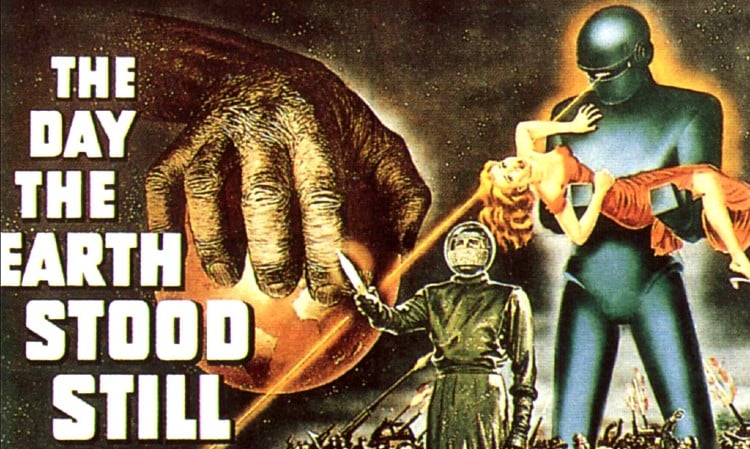
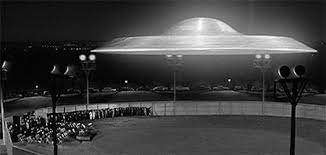
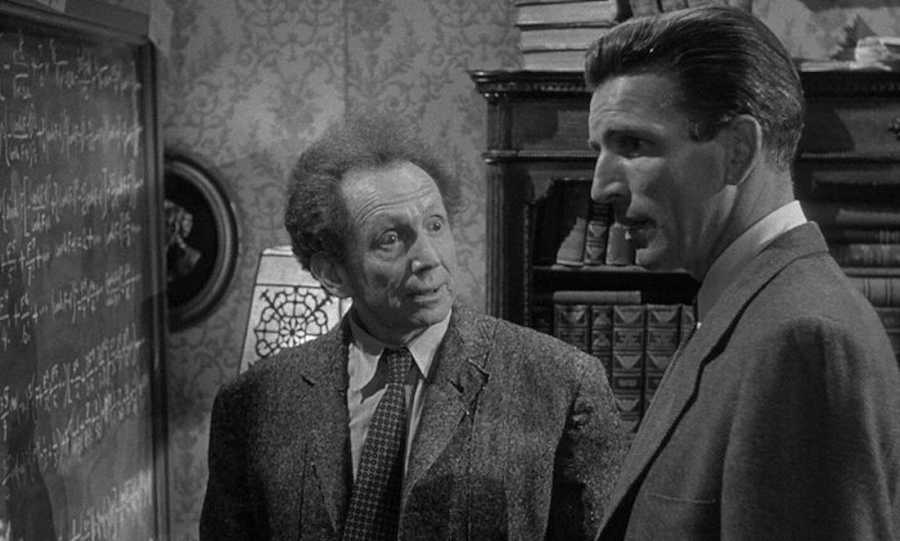
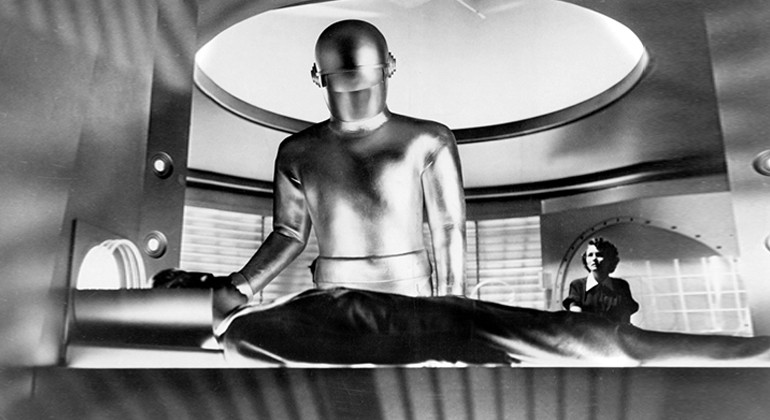

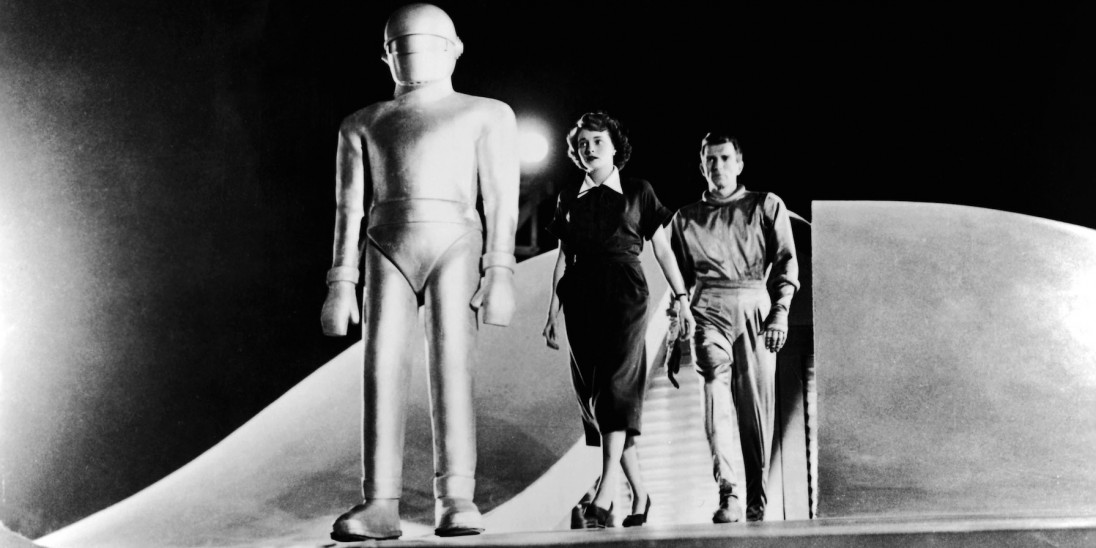

No comments:
Post a Comment